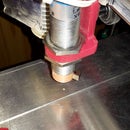Introduction: Working Procedure to Make Raspberry Pi 2b V1.1 Boot From Usb Sata SSD
After spent several days looking for a way to let my Pi 2B V1.1 boot from Usb SSD without good results (I tried all of them), finally I found two really working tricks.
I think that other peoples in the world own an Pi 2B v1.1 confined within the limits of the SD, so I thought I'd share with them the following.
I personal tested the procedure two times, and always all gone well.
I don't exlude it can work on more recent Pis, avoiding to manage OTP and other stuff...
I greatly thank RonR and PiHome (see credits at BOP).
P.S. I’m not a Linux expert, so please don’t put me nerd questions 8-D
Let's go on...
Step 1: PREPARE FOR USB BOOT
Step 1.1
in Windows:
- Download latest Raspbian Buster from images server
- Download Win32 Disk Imager from this link
- Flash Buster on a 16/324GB SD with Win32 Disk Imager
- Add an empty file named 'ssh' to the boot (VFAT) partition of your SD card to enable SSH
Step 1.2
in RPi:
- Insert the SD into the Raspberry and power on
- Complete the base installation in the normal way
- Power off RPi
Step 1.3
in Windows:
- Create an image of SD with Win32 Disk Imager and name it Buster_installed.img
- Connect your SSD to USB
- If new, quick format it as FAT32
- Flash Buster_installed image on the SSD with Win32 Disk Imager
- Disconnect the SSD
Step 1.4
in RPi
Insert the SD and the SSD into the Raspberry and power on
From now on all the PARTUUID shown are only for example, you’ve to use yours…
Now type
sudo ls /dev/disk/by-partuuid
the output:
pi@raspberrypi:~ $ Sudo ls /dev/disk/by-partuuid
16f266b1-01 16f266b1-02 2f1ce4b1-01 2f1ce4b1-02
If the PARTUUID are the same (and it should be):
Type:
sudo fdisk /dev/sda
Welcome to fdisk (util-linux 2.34).
Changes will remain in memory only, until you decide to write them.
Be careful before using the write command.
Command (m for help): x # enter x to go to expert menu
Expert command (m for help): i # enter i to change identifier
Here below put random 8 numbers/letters
Enter the new disk identifier: 0x60123f76 # at your choice
Disk identifier changed from 0x60123f75 to 0x60123f76.
Expert command (m for help): r # enter r to return to main menu
Command (m for help): w # enter w to write change to MBR
The partition table has been altered.
Calling ioctl() to re-read partition table.
Syncing disks.
Now type
sudo ls /dev/disk/by-partuuid
For sure now the PARTUUID are different.
Step 1.5
Open a terminal and type
blkid
the output’:
pi@raspberrypi:~ $ blkid
/dev/mmcblk0p1: LABEL_FATBOOT="boot" LABEL="boot" UUID="B05C-D0C4" TYPE="vfat" PARTUUID="2f1ce4b1-01"
/dev/mmcblk0p2: LABEL="rootfs" UUID="075b0d0c-7b1e-4855-9547-125591698723" TYPE="ext4" PARTUUID="2f1ce4b1-02"
Here you find the SD PARTUUID (ex. 2f1ce4b1-02)
Step 1.6
Now type
sudo ls /dev/disk/by-partuuid
the output:
pi@raspberrypi:~ $ Sudo ls /dev/disk/by-partuuid
60123f76-01 60123f76-02 2f1ce4b1-01 2f1ce4b1-02
Here you find the SSD PARTUUID (ex. 60123f76-02), usually /dev/sda2
Now type:
sudo nano /boot/cmdline.txt
Find “root=PARTUUID=2f1ce4b1-02”, replace with “root=PARTUUID=60123f76-02” and save
Type:
sudo reboot
If all is OK Raspberry should now boot from SSD.
Note that all above doesn’t compromise the original SD.
You can at anytime, simply running STEP 1.5 with the original SD’s PARTUUID, revert to SD boot.
Done!
Step 2: RESIZE SSD
Read carefully PiHome page .
It works exactly as stated.
If all is OK Raspberry should now boot from SSD and make a check disk.
Once finished it will stop on a grey screen with trhee white square dots; wait a minute or two to be sure nothing happens further, then power off and on again.
Voilà…
Step 3: Done!
Many thanks to:
RonR @ https://www.raspberrypi.org/forums/viewtopic.php?...
PiHome @ https://www.pihome.eu/2020/01/13/resizing-the-usb...










